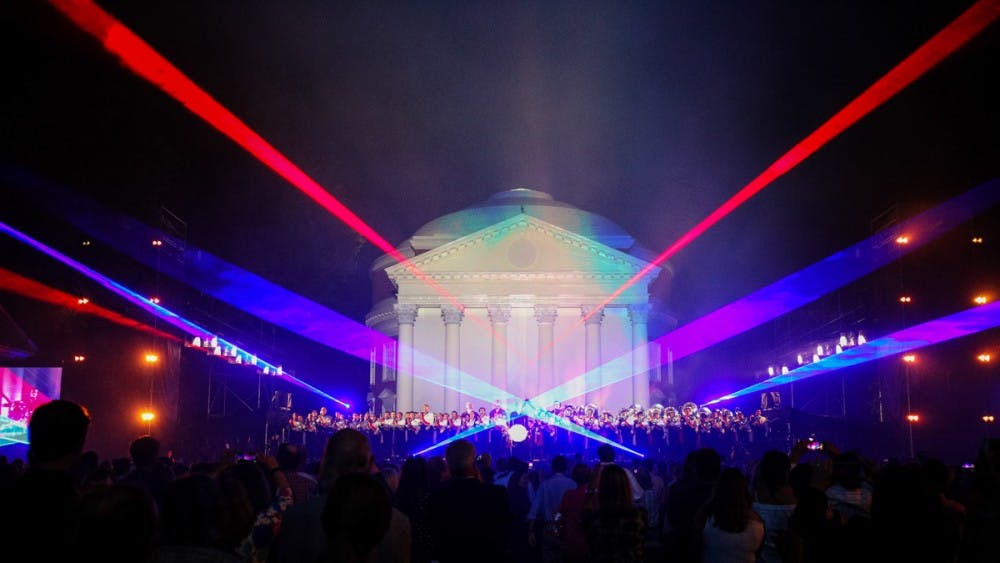Two hundred years of University history — both good and bad — were celebrated on the Lawn last Friday night. Performers including Leslie Odom Jr., Andra Day and various student groups came together to tell the story of the University’s illustrious past. A captivating projection mapping display visually showcased the transformation of the Lawn from the laying of the first cornerstone on Oct. 6, 1817 to the pioneering academic institution that the University has become today. While the better parts of the University’s history were certainly showcased, the organizers of the Bicentennial Launch Celebration did a worthy job of also exhibiting the not so admirable parts of University’s history. The freed and enslaved laborers who built the University, Thomas Jefferson’s ownership of slaves and the very recent admittance of women to the University were all represented in the event. The Bicentennial Launch Celebration was a time to reflect on all parts of the University’s history — and a time to plan the creation of a more accepting, inclusive and progressive University in the years to come.
The observance of milestones and birthdays presents a time to reflect on and learn from history. After all, as George Santayana said, “those who do not learn from history are doomed to repeat it.” By acknowledging the more difficult aspects of the University’s history, the next two years of the Bicentennial Celebration present an opportunity for students, faculty, alumni and the rest of the country to learn from the University’s troubled past and improve the institution for the years to come. The celebration highlighted the advancements in equality that the University has seen in the last 200 years — including the admittance of women and individuals from a variety of nations, ethnicities, cultures and socio-economic levels. These additions have only served to enrich the diverse academic environment that Thomas Jefferson envisioned for the University.
Unlike other University events, the Bicentennial Launch Celebration did not attempt to dodge the challenging aspects of University history. Instead it confronted them directly — starting with the commencement of the evening with the projection mapping of freed and enslaved laborers constructing the Rotunda and the academical village. After the construction of the Lawn, the performance displayed images of the first students of the University — white wealthy men. With this depiction, the celebration acknowledged that the majority of current students would not have been accepted at the University two centuries years ago. This serves to not only demonstrate the changes which can occur over a relatively short period of time, but also the merits which increased diversity has brought to our institution.
From the first class of students at the University, the projection mapping continued to trace history through the Civil War. The performance acknowledged the roles that students played on both sides of the war, with the majority fighting for and supporting the Confederacy. Following the mapping of the Civil War, the descendants of freed and enslaved laborers of Monticello were welcomed onto the stage. Several of the descendants candidly recounted the stories of their ancestors. The organizers of the Bicentennial could have easily omitted these individuals from the celebration, but by including them in the event a more accurate and complete history of the University was showcased. This thorough portrayal of University history continued throughout the night. University alumnus Katie Couric welcomed to the stage several of the pioneering women who were among the first to graduate from the University in the mid-1970s. The youthful smiling faces of these women served as compelling reminders of recent systemic inequality at the University — that less than 50 years ago women graduated from the University for the first time. This open confrontation of the imperfect history of the University demonstrates a divergence in the manner in which University history has been conventionally discussed.
Many argue that the Bicentennial Celebration is a commemoration of 200 years of white supremacy, but the celebration did nothing to refute this claim. It embraced all aspects of the University’s storied history regardless of how challenging or controversial they are. While the University did not openly denounce Thomas Jefferson for being a slave owner, pledge to knock down the Rotunda or promise the removal of all statues to Thomas Jefferson and other white supremacists on Grounds, the University provided a comprehensive and accurate portrayal of history while maintaining the positive outlook of the launch celebration. As the Bicentennial celebrations extend over the next two years, let us look to the coming years as we continue to excel and advance our University towards a more just and inclusive future.
Mary Alice Kukoski is a Viewpoint writer for The Cavalier Daily. She can be reached at opinion@cavalierdaily.com.





